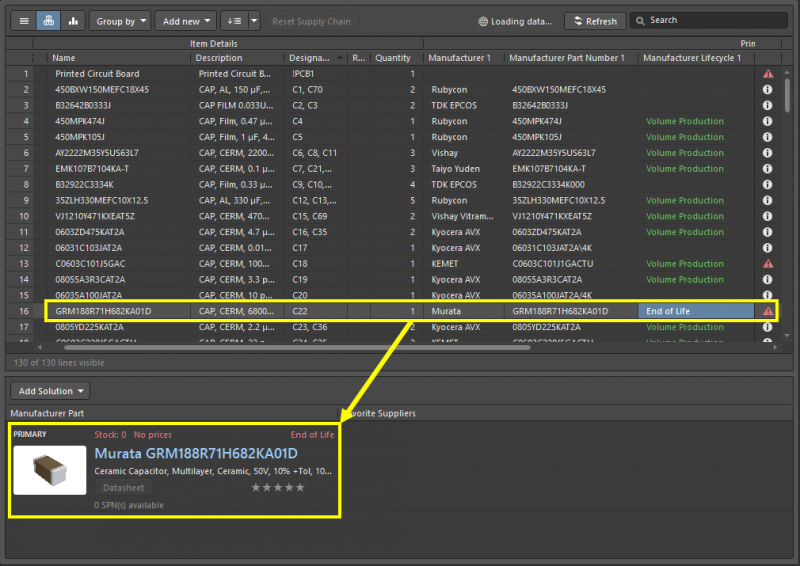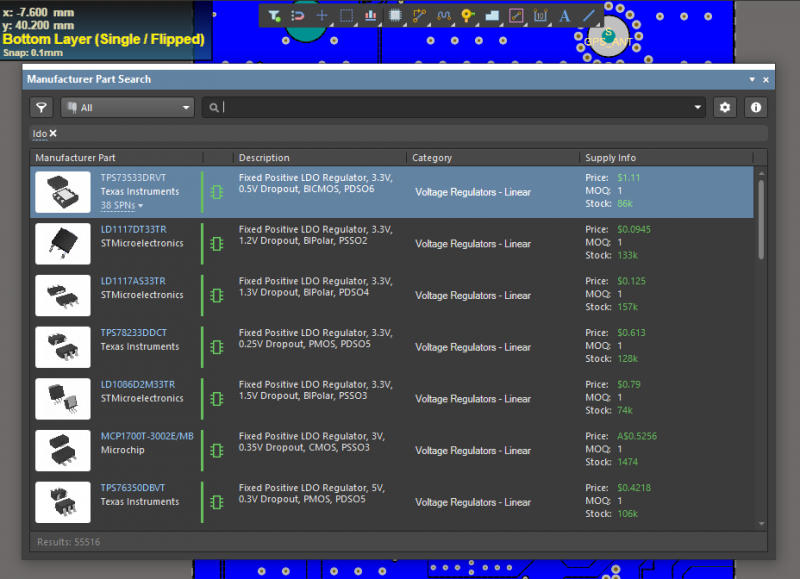Managing Component Parts Obsolescence with a Unified Data Solution

Altium Concord Pro™ as a standalone product and brand name has been discontinued and the capabilities are now available as part of our Altium enterprise solutions. Learn more here.
If components stayed competitive forever, your smartphone would run on vacuum tubes. Obsolescence is an essential part of electronics. It represents an advance in technology, although it is incremental. However, it can also create some pain points for PCB designers, especially when they don’t use the right component management tools.
Overcoming problems that arise from poor obsolescence management and lack of supply chain visibility takes the right data management features within your PCB design software. With the right data management solution, you can quickly import data updates directly into your design documents. Altium 365 provides just this type of data management environment, where design teams will have access to the supply chain information they need to stay competitive and the ability to share design data with collaborators instantly.
ALTIUM 365®
A unified data management platform that provides real-time supply chain updates and collaboration features within Altium Designer®.
Every component will go obsolete eventually, and no component has an infinite lifetime.
This doesn’t just refer to the operational lifetime of an electronic component. Eventually, a given component will be replaced with a new version, and designs will need to be updated with fresh components to ensure they will have a longer useful lifetime. Component updates force more than just replacing components within a design, they force a design team to update their PCB libraries so that they have the most recent data on their components.
Within your ECAD software, this means the component could have a new schematic symbol, printed circuit board footprint, mechanical model, or simulation model. Any of these changes will affect your design and will require modifications to your board, your bill of materials, and fabrication files. With the untold number of electronic components available on the market, obsolescence management is already difficult, and PCB designers need supply chain visibility throughout the design process if they want to avoid an unnecessary redesign.
Identifying Problems in PCB Obsolescence Management
Some components, like passives, aren’t updated as often as integrated circuits, and they are not significantly different from an old component. However, with active components, specialized passives or semiconductors, connectors, and other electronic components, newer versions of an existing component may be significantly different. The data that is updated in a component can include CAD data, distributor information, prices, and much more.
Whether obsolete components in a design need to be updated and replaced is up for debate and it depends on the design’s intended application. For some designers, including obsolete components means a design may not be manufacturable later, so it will need to be updated. For prototypes, including some obsolete components may not matter as long as they can be easily replaced later. No matter the situation, designers need the ability to quickly identify obsolete electronic components at multiple stages in the design process.
Designers that don’t have the right component lifecycle management software can find themselves falling victim to any of the following problems:
Your Supply Chain Tools Only Provide Stale Component Data
Even if your PCB design software includes a component management solution, you put yourself at risk that it doesn’t update lifecycle and supplier data. Changes in the supply chain can happen quickly, and some data solutions do not provide real-time supply chain updates directly within your design software. This puts you at risk of including obsolete, soon-to-be-obsolete, or end-of-life components in your design.
When this happens, you typically don’t find out about the problem until your manufacturer informs you that your lead time just jumped from a few weeks to a few months. This increases your time to market and ultimately makes you less competitive. Overcoming this issue requires real-time supply chain data that can be accessed by any member of your design team.

Don’t wait until manufacturing to remove EOL components from a design.
Team Sharing of Design Libraries is Inefficient
Because the supply chain moves so quickly, PCB design times that are working remotely can find that their libraries quickly go stale and need to be updated. Early in the design phase, every member of a design team needs access to verified component data, including lifecycle information. Once one designer updates their data, how can they be sure that their project collaborators are using the same set of design files and libraries?
In the past, designers had to rely on an unwieldy local network or email to deliver library files and share critical design data. Getting this wrong or forgetting to send the right data can lead to unnecessary redesigns and even failed production runs. To ensure projects are completed successfully, design teams need a simple, integrated solution for managing and sharing their design data, including component lifecycle status.
Your 3rd Party Supply Chain Management Tools Don’t Integrate With Your Design Software
You might have found a software solution or signed up for a service that provides some level of supply chain visibility, allowing you to anticipate sourcing problems and redesigns early in the design phase. This is a much better option than waiting to send your board off for manufacturing, only to find out your lead times are significantly longer than you expected, or your required components are out of stock.
Unfortunately, these 3rd party component obsolescence management and supply chain visibility tools don’t integrate with your PCB design software. Once you find that important component data has been updated or that a desired component will soon become unsourceable, it is difficult to quickly locate and import a suitable replacement component into your design documents. When this happens, you’re stuck browsing distributor websites and updating your design documents manually.

Component lifecycle and revision states can be viewed in Altium Designer and the Altium 365 platform.
How Altium Designer and Altium 365 Streamline Management of PCB Component Obsolescence
Working through any problems related to a lack of current parts data and obsolescence management requires a number of important management tools. Working with your own component information database won’t do the trick, especially when it comes to ensuring design data in your PCB libraries remains current. Instead, you need a solution with the following features:
Supply Chain Visibility Early in the Design Process
Looking at the PCB component supply chain early during design is the best way to prevent redesigns that can arise due to obsolescence. This helps you identify components that will soon reach the end of their lifecycle and adjust your sourcing strategy as necessary. You can then ensure that the components in your board will be sourceable once your board is sent off for manufacturing.
Altium 365 makes this possible by providing supplier and lifecycle data to Altium Designer users through the Manufacturer Part Search panel. This feature is accessible in Altium Designer at all stages of the design process. A designer can search for verified parts, view souring information, download symbols and footprints, and spot obsolete components in a single window within Altium Designer. This integration between Altium Designer and Altium 365 is the ideal solution for managing component obsolescence throughout the design cycle.

The Manufacturer Part Search panel is easily accessed within Altium Designer.
Integration With Your Design Features
When design data are easy to share and access through the cloud, it’s a simple matter to import updated data into Altium Designer. Altium 365 was built to help design teams quickly import shared data into Altium Designer and provide revision control for all aspects of a design. This is critical when removing EOL components during a design update or when creating a new design.
Sharing Design Data is Secure and Easy
Altium 365 brings Altium Designer’s world-class data management and supply chain features onto the cloud, giving your entire design team a simple way to store and share design data in a secure environment. Altium 365 is the industry’s first cloud platform for electronics data management and sharing, including component data and supply chain management. Everyone on a design team will have access to a complete set of sharing and version control features, which helps designers stay productive and stay ahead of component obsolescence.

Designers can easily share design data with each other and manufacturers with Altium 365.
Printed Circuit Design and Lifecycle Management in Altium 365
Altium 365 solves all these component management problems and many more by integrating within Altium Designer. Component sourcing data and lifecycle data are available within Altium Designer via the Altium 365 platform, and this same data is available through your web browser. In addition, you can store, share, and collaborate through the cloud thanks to Altium 365, the industry’s only complete data sharing and management solution that integrates with Altium Designer.
If you want to bring the world-class data management features in Altium 365 on-premises, you can deploy an instance of Altium Concord Pro on your own infrastructure. This enterprise-level application provides a range of component and data management features on-premises and within Altium Designer. You won’t have to switch between design and management programs to take advantage of the management and sharing features in Altium Concord Pro or Altium 365.
- Altium Designer’s complete suite of layout and management tools are integrated into a single application, giving designers everything they need for circuit board design and managing component obsolescence in a single program.
Learn more about Altium Designer’s unified design environment.
- The Altium 365 platform gives Altium Designer users access to a complete solution for component obsolescence management and sharing. It’s easy to share and manage design data within Altium Designer or in a web browser.
- Altium Concord Pro provides an enterprise-level solution for component obsolescence management and supply chain visibility on-premises.
Learn more about enhancing Altium Designer with Altium Concord Pro.

Easily store, share, and manage all your design data through the Altium 365 platform and Altium Designer.
Instead of using spreadsheets or databases for managing component obsolescence, use the complete set of design features in Altium Designer and the component lifecycle management features in the Altium 365 platform. You can take control of the design and component sourcing processes with the supply chain features in Altium’s complete platform for PCB design and management.
Altium Designer on Altium 365 delivers unprecedented integration to the electronics industry until now relegated to the world of software development, allowing designers to work from home and reach unprecedented levels of efficiency.
We have only scratched the surface of what is possible to do with Altium Designer on Altium 365. You can check the product page for a more in-depth feature description or one of the On-Demand Webinars.















